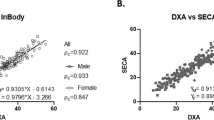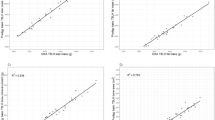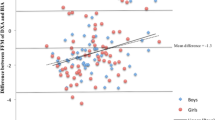Abstract
Background
Obesity and age influence the reliability of dual energy X-ray absorptiometry scanning (DEXA) and bioimpedance spectroscopy (BIS). Both are used in clinical settings, but have not been compared for measurements in obese children. We compared DEXA and BIS for evaluating body composition and inherent changes in obese children before and after a 10-month weight loss programme.
Methods
DEXA and BIS were used to evaluate 130 patients at baseline and 75 at follow-up. We tested agreement between the two techniques using Bland–Altman plots and proportional bias using Passing–Bablok regressions.
Results
The Bland–Altman plots showed wide agreement limits before and after weight loss and when monitoring longitudinal changes. At baseline, the Passing–Bablok regressions revealed a proportional bias for all body compartments. After significant weight loss no proportional bias was found for fat mass and percentage, although BIS systematically underestimated fat mass by 2.9 kg. Longitudinally, no proportional bias was found in the measured changes of absolute fat, fat-free mass and fat-free percentage between both methods, although BIS systematically underestimated fat and fat-free mass by 2.6 and 0.7 kg, respectively.
Conclusion
While BIS and DEXA are not interchangeable at baseline, the agreement between the two improved after significant weight loss. Proportional changes in fat mass, fat-free mass and fat-free percentage were similar for both techniques. BIS is a viable alternative to DEXA for future paediatric obesity studies measuring treatment effect at group levels, but is not superior to DEXA and cannot be used for monitoring individual changes due to wide limits of agreement.
This is a preview of subscription content, access via your institution
Access options
Subscribe to this journal
Receive 12 print issues and online access
$259.00 per year
only $21.58 per issue
Buy this article
- Purchase on Springer Link
- Instant access to full article PDF
Prices may be subject to local taxes which are calculated during checkout



Similar content being viewed by others
References
Malecka-Tendera E, Mazur A. Childhood obesity: a pandemic of the twenty-first century. Int J Obes. 2006;30:S1–3.
Andreoli A, Garaci F, Cafarelli FP, Guglielmi G. Body composition in clinical practice. Eur J Radio. 2016;85:1461–8.
Javed A, Jumean M, Murad MH, Okorodudu D, Kumar S, Somers VK, et al. Diagnostic performance of body mass index to identify obesity as defined by body adiposity in children and adolescents: a systematic review and meta-analysis. Pediatr Obes. 2015;10:234–44.
Hendel HW, Gotfredsen A, Andersen T, Højgaard L, Hilsted J. Body composition during weight loss in obese patients estimated by dual energy X-ray absorptiometry and by total body potassium. Int J Obes Relat Metab Disord. 1996;20:1111–9.
Brownbill RA, Ilich JZ. Measuring body composition in overweight individuals by dual energy x-ray absorptiometry. BMC Med Imaging. 2005;5:1.
Sopher AB, Thornton JC, Wang J, Pierson RN, Heymsfield SB, Horlick M. Measurement of percentage of body fat in 411 children and adolescents: a comparison of dual-energy X-ray absorptiometry with a four-compartment model. Pediatrics. 2004;113:1285–90.
Smith-Ryan AE, Mock MG, Ryan ED, Gerstner GR, Trexler ET, Hirsch KR. Validity and reliability of a 4-compartment body composition model using dual energy x-ray absorptiometry-derived body volume. Clin Nutr. 2017;36:825.
Cox-Reijven P, van Kreel B, Soeters P. Accuracy of bioelectrical impedance spectroscopy in measuring changes in body composition during severe weight loss. J Parenter Enter Nutr. 2002;26:120–7.
Moissl UM, Wabel P, Chamney PW, Bosaeus I, Levin NW, Bosy-Westphal A, et al. Body fluid volume determination via body composition spectroscopy in health and disease. Physiol Meas. 2006;27:921.
Wabel P, Chamney P, Moissl U, Jirka T. Importance of whole-body bioimpedance spectroscopy for the management of fluid balance. Blood Purif. 2009;27:75–80.
Dasgupta I, Keane D, Lindley E, Shaheen I, Tyerman K, Schaefer F, et al. Validating the use of bioimpedance spectroscopy for assessment of fluid status in children. Pediatr Nephrol. 2018;33:1601–7.
Matthie JR. Bioimpedance measurements of human body composition: critical analysis and outlook. Expert Rev Med Devices. 2008;5:239–61.
Roelants M, Hauspie R, Hoppenbrouwers K. References for growth and pubertal development from birth to 21 years in Flanders, Belgium. Ann Hum Biol. 2009;36:680–94.
Cole TJ, Bellizzi MC, Flegal KM, Dietz WH. Establishing a standard definition for child overweight and obesity worldwide: international survey. BMJ. 2000;320:1240.
Jaworski M, Pludowski P. Precision errors, least significant change, and monitoring time interval in pediatric measurements of bone mineral density, body composition, and mechanostat parameters by GE Lunar Prodigy. J Clin Densitom. 2013;16:562–9.
Margulies L, Horlick M, Thornton JC, Wang J, Ioannidou E, Heymsfield SB. Reproducibility of pediatric whole body bone and body composition measures by dual-energy X-ray absorptiometry using the GE Lunar Prodigy. J Clin Densitom. 2005;8:298–304.
Bazzocchi A, Ponti F, Albisinni U, Battista G, Guglielmi G. DXA: Technical aspects and application. Eur J Radio. 2016;85:1481–92.
Mulasi U, Kuchnia AJ, Cole AJ, Earthman CP. Bioimpedance at the bedside: Current applications, limitations, and opportunities. Nutr Clin Pr. 2015;30:180–93.
Bland JM, Altman DG. Measuring agreement in method comparison studies. Stat Methods Med Res. 1999;8:135–60.
Passing H, Bablok W. A new biometrical procedure for testing the equality of measurements from two different analytical methods. Application of linear regression procedures for method comparison studies in clinical chemistry, Part I. J Clin Chem Clin Biochem. 1983;21:709–20.
IBM SPSS Statistics for Macintosh, version 25 (Armonk, N.Y., USA: IBM Corp).
Addinsoft. XLSTAT statistical and data analysis solution. Long Island, NY, USA. 2019. https://www.xlstat.com.
Fors H, Gelander L, Bjarnason R, Albertsson-Wikland K, Bosaeus I. Body composition, as assessed by bioelectrical impedance spectroscopy and dual-energy X-ray absorptiometry, in a healthy paediatric population. Acta Paediatr. 2007;91:755–60.
Ellegård L, Bertz F, Winkvist A, Bosaeus I, Brekke HK. Body composition in overweight and obese women postpartum: bioimpedance methods validated by dual energy X-ray absorptiometry and doubly labeled water. Eur J Clin Nutr. 2016;70:1181–8.
Pateyjohns IR, Brinkworth GD, Buckley JD, Noakes M, Clifton PM. Comparison of three bioelectrical impedance methods with DXA in overweight and obese men. Obesity 2006;14:2064–70.
Svantesson U, Zander M, Klingberg S, Slinde F. Body composition in male elite athletes, comparison of bioelectrical impedance spectroscopy with dual energy X-ray absorptiometry. J Negat Results Biomed. 2008;7:1.
Moissl U, Wabel P, Chamney PW, Bosy-Westphal A, Korth O, Mueller M. et al. Validation of a 3C model for determination of body fat mass. J Am Soc Nephrol. 2007;18:257A.
Zhou Y, Höglund P, Clyne N. Comparison of DEXA and bioimpedance for body composition measurements in nondialysis patients with CKD. J Ren Nutr. 2019;29:33–8.
Lim PS, Chen CH, Zhu F, Kotanko P, Jeng Y, Hu CY, et al. Validating body fat assessment by bioelectric impedance spectroscopy in Taiwanese hemodialysis patients. J Ren Nutr. 2017;27:37–44.
Popovic V, Zerahn B, Heaf JG. Comparison of dual energy X-ray absorptiometry and bioimpedance in assessing body composition and nutrition in peritoneal dialysis patients. J Ren Nutr. 2017;27:355–63.
Ward LC, Dyer JM, Byrne NM, Sharpe KK, Hills AP. Validation of a three-frequency bioimpedance spectroscopic method for body composition analysis. Nutrition. 2007;23:657–64.
Ellis KJ, Shypailo RJ, Wong WW. Measurement of body water by multifrequency bioelectrical impedance spectroscopy in a multiethnic pediatric population. Am J Clin Nutr. 1999;70:847–53.
Roemmich JN, Clark PA, Weltman A, Rogol AD. Alterations in growth and body composition during puberty. I. Comparing multicompartment body composition models. J Appl Physiol. 1997;83:927–35.
Wong WW, Hergenroeder AC, Stuff JE, Butte NF, O’Brian Smith E, Ellis KJ. Evaluating body fat in girls and female adolescents: advantages and disadvantages of dual-energy X-ray absorptiometry. Am J Clin Nutr. 2002;76:384–9.
Gately PJ, Radley D, Cooke CB, Carroll S, Oldroyd B, Truscott JG, et al. Comparison of body composition methods in overweight and obese children. J Appl Physiol. 2003;95:2039–46.
Goodsitt MM. Evaluation of a new set of calibration standards for the measurement of fat content via DPA and DXA. Med Phys. 1992;19:35–44.
Levitt DG, Beckman LM, Mager JR, Valentine B, Sibley SD, Beckman TR, et al. Comparison of DXA and water measurements of body fat following gastric bypass surgery and a physiological model of body water, fat, and muscle composition. J Appl Physiol. 2010;109:786–95.
Birzniece V, Khaw C-H, Nelson AE, Meinhardt U, Ho KKY. A critical evaluation of bioimpedance spectroscopy analysis in estimating body composition during GH treatment: comparison with bromide dilution and dual X-ray absorptiometry. Eur J Endocrinol. 2015;172:21–8.
Weber DR, Leonard MB, Zemel BS. Body composition analysis in the pediatric population. Pediatr Endocrinol Rev. 2012;10:130–9.
Wells JC, Williams JE, Chomtho S, Darch T, Grijalva-Eternod C, Kennedy K, et al. Pediatric reference data for lean tissue properties: density and hydration from age 5 to 20 y. Am J Clin Nutr. 2010;91:610–8.
Wang Z, Deurenberg P, Wang W, Pietrobelli A, Baumgartner RN, Heymsfield SB. Hydration of fat-free body mass: review and critique of a classic body-composition constant. Am J Clin Nutr. 1999;69:833–41.
Pietrobelli A, Formica C, Wang Z, Heymsfield SB. Dual-energy X-ray absorptiometry body composition model: review of physical concepts. Am J Physiol Metab. 1996;271:E941–51.
Chamney PW, Wabel P, Moissl UM, Müller MJ, Bosy-Westphal A, Korth O, et al. A whole-body model to distinguish excess fluid from the hydration of major body tissues. Am J Clin Nutr. 2007;85:80–9.
Broers NJH, Canaud B, Dekker MJE, van der Sande FM, Stuard S, Wabel P, et al. Three compartment bioimpedance spectroscopy in the nutritional assessment and the outcome of patients with advanced or end stage kidney disease: what have we learned so far? Hemodial Int. 2020;24:148–61.
Waki M, Kral JG, Mazariegos M, Wang J, Pierson RN, Heymsfield SB. Relative expansion of extracellular fluid in obese vs. nonobese women. Am J Physiol Metab. 1991;261:E199–203.
Horber FF, Thomi F, Casez JP, Fonteille J, Jaeger P. Impact of hydration status on body composition as measured by dual energy X-ray absorptiometry in normal volunteers and patients on haemodialysis. Br J Radio. 1992;65:895–900.
Mager JR, Sibley SD, Beckman TR, Kellogg TA, Earthman CP. Multifrequency bioelectrical impedance analysis and bioimpedance spectroscopy for monitoring fluid and body cell mass changes after gastric bypass surgery. Clin Nutr. 2008;27:832–41.
Thomson R, Brinkworth GD, Buckley JD, Noakes M, Clifton PM. Good agreement between bioelectrical impedance and dual-energy X-ray absorptiometry for estimating changes in body composition during weight loss in overweight young women. Clin Nutr. 2007;26:771–7.
Van Eyck A, De Guchtenaere A, Van Gaal L, De Backer W, Verhulst SL, Van Hoorenbeeck K. Clinical predictors of residual sleep apnea after weight loss therapy in obese adolescents. J Pediatr. 2018;196:189–193.e1.
Bruyndonckx L, Hoymans VY, De Guchtenaere A, Van Helvoirt M, Van Craenenbroeck EM, Frederix G, et al. Diet, exercise, and endothelial function in obese adolescents. Pediatrics 2015;135:e653–61.
Summerbell C, Ashton V, Campbell K, et al. Interventions for treating obesity in children. Cochrane Database Syst Rev. 2003;3:CD001872.
Eerens S, van der Lee J, Bael A, Trouet D, Van Hoeck K. Reproducibility of the body composition monitor in healthy children. Pediatr Nephrol.2011;26:1636.
Wabel P, Chamney PW, Moissl U. Reproducibility of bioimpedance spectroscopy (BIS) in health and disease. Nephrol Dial Transpl. 2007;22:137.
Acknowledgements
We would like to thank all patients and their parents for participating in our study. Furthermore, we would like to thank our colleagues from ‘Het Zeepreventorium’ and Eddy Basslé specifically for providing us with a venue in which to conduct our measurements.
Funding
This publication was made possible with financial support from the ‘Fonds voor Wetenschappelijk Onderzoek’ (FWO), FWO-TBM project number 150179.
Author information
Authors and Affiliations
Contributions
All authors certify that they have participated in the study and take responsibility for the content. The study was designed by MY, AVE, KVH, SV, BDW, LB, MVH and ADG. Measurements were performed by MY, AVE and EV and the database was made by MY, EV and AVE. Data were analysed by EV, AVE under the supervision of SV, who has a Master’s degree in Statistics. Data interpretation was done by EV, AVE, SV, KVH, BDW and KVD. All authors were involved in the writing of the manuscript.
Corresponding author
Ethics declarations
Conflict of interest
The authors declare that they have no conflict of interest.
Ethical approval
The local ethics committee approved this study (EC n°B670201731779).
Informed consent
Written informed consent was obtained from the patients and their parents or legal guardians.
Additional information
Publisher’s note Springer Nature remains neutral with regard to jurisdictional claims in published maps and institutional affiliations.
Rights and permissions
About this article
Cite this article
Vermeiren, E., Ysebaert, M., Van Hoorenbeeck, K. et al. Comparison of bioimpedance spectroscopy and dual energy X-ray absorptiometry for assessing body composition changes in obese children during weight loss. Eur J Clin Nutr 75, 73–84 (2021). https://doi.org/10.1038/s41430-020-00738-9
Received:
Revised:
Accepted:
Published:
Issue Date:
DOI: https://doi.org/10.1038/s41430-020-00738-9
This article is cited by
-
Body composition monitoring in children and adolescents: reproducibility and reference values
European Journal of Pediatrics (2021)



